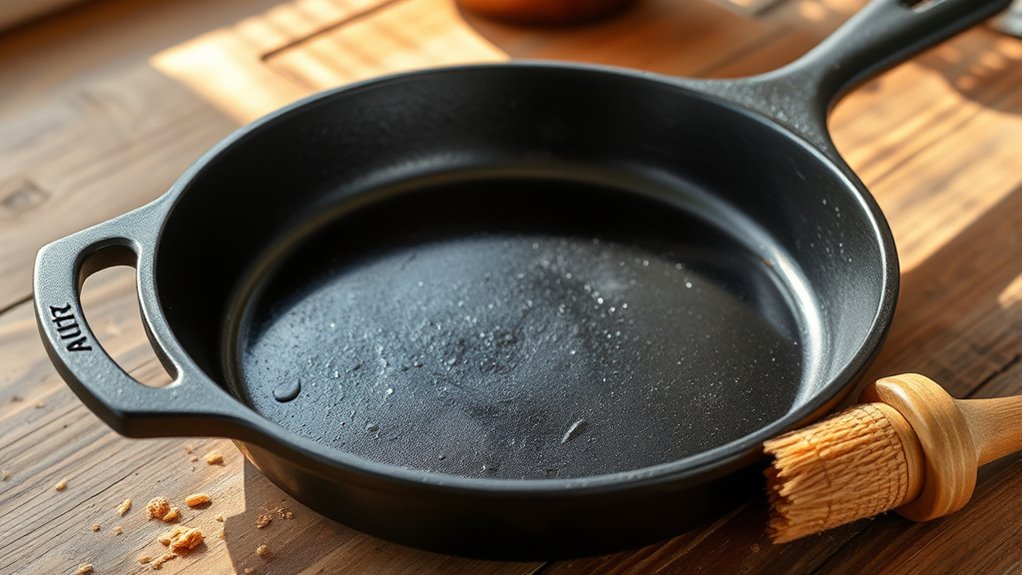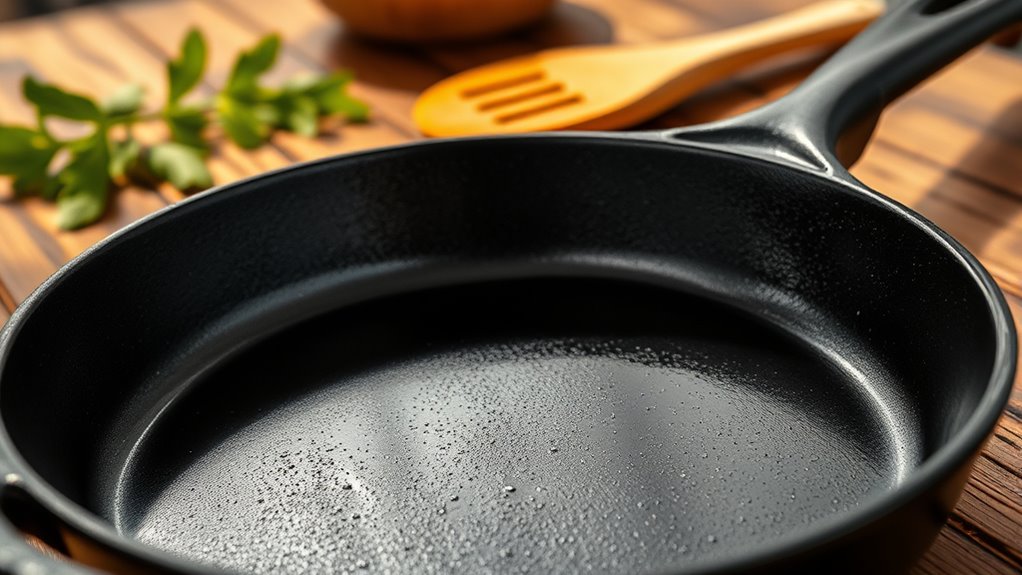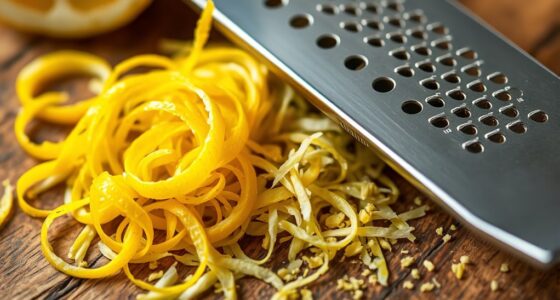To season your cast iron the stress-free way, start by thoroughly cleaning the pan with hot water and a brush, then dry it completely. Apply a thin, even layer of a high-smoke-point oil like flaxseed or vegetable oil, wiping off any excess. Place the pan upside down in a preheated 450°F oven for about an hour, then let it cool inside. Keeping it simple means you’ll soon enjoy a naturally non-stick, durable surface—if you keep going, you’ll uncover even more tips.
Key Takeaways
- Clean your cast iron thoroughly, avoiding soap, then dry completely to prevent rust.
- Apply a thin, even layer of high-smoke-point oil over the entire surface and handle.
- Preheat your oven to 450°F, place the pan upside down, and bake for about one hour.
- Let the pan cool completely inside the oven to set the seasoning properly.
- Use the pan regularly; routine cooking and cleaning will naturally enhance the seasoning over time.

Have you ever wondered why some cast iron pans develop a smooth, shiny surface that improves with use? It’s all about seasoning—a process that creates a natural non-stick coating and protects the pan from rust. When done correctly, seasoning turns your skillet into a culinary workhorse, making food release effortlessly and cleaning easier. The best part? You don’t need fancy products or complicated steps. With a few simple techniques, you can season your cast iron stress-free and enjoy a lifetime of excellent cooking.
Start by cleaning your pan thoroughly. Even if it looks seasoned, wash it with warm water and a brush or sponge to remove any factory coatings or residues. Avoid soap, as it can strip away the initial layer of seasoning. Dry the pan completely—water left behind can cause rust, undoing your efforts. To speed up drying, place the pan on a stovetop over low heat for a few minutes. Once dry, apply a light coat of oil all over the surface, including the handle. Use a high-smoke-point oil like flaxseed, grapeseed, or vegetable oil; you only need a thin layer. Too much oil can lead to a sticky surface, so wipe off any excess with a paper towel or cloth.
Now comes the heating process. Preheat your oven to around 450°F (232°C). Place the pan upside down on the middle rack, with a sheet of aluminum foil or a baking sheet on the lower rack to catch any drips. Bake the pan for about an hour. This high heat polymerizes the oil, creating a durable, smooth coating. After an hour, turn off the oven and let the pan cool completely inside. This slow cooling helps the seasoning set properly. Once cooled, your pan will have a shiny, almost black patina that’s ready for use.
Frequently Asked Questions
How Often Should I Re-Season My Cast Iron Skillet?
You should re-season your cast iron skillet whenever the cooking surface starts to look dull, rust appears, or food begins to stick more than usual. Typically, this means reseasoning every few months or after about 10-15 uses. Keep an eye on how your skillet performs; if it loses its non-stick qualities or shows signs of wear, it’s time to give it a quick re-season. Regular maintenance keeps it in top shape.
Can I Use Soap When Cleaning My Seasoned Cast Iron?
Yes, you can use soap when cleaning your seasoned cast iron skillet, but it’s best to do so sparingly. Soap won’t ruin the seasoning if used occasionally, especially if you rinse thoroughly afterward. Avoid harsh soaps or scrubbing with abrasive pads often, as they can strip away the seasoning over time. For regular cleaning, hot water and a brush usually do the trick, helping maintain your skillet’s non-stick surface.
What’s the Best Oil for Seasoning Cast Iron?
You should use vegetable oil, flaxseed oil, or canola oil for seasoning your cast iron. These oils have high smoke points and polymerize well, creating a durable non-stick surface. Avoid using butter or olive oil, as they don’t withstand high heat and can create a sticky residue. Apply a thin, even layer of oil and bake your skillet to achieve the best seasoning results.
How Do I Fix a Sticky Cast Iron Surface?
If your cast iron’s sticky, don’t panic. First, scrub the surface with a steel wool or abrasive pad to remove the excess residue. Then, dry it thoroughly and apply a thin layer of oil. Place it upside down in the oven at 450°F for an hour, letting the heat bake out the stickiness. Repeat this process if necessary, and soon your pan will be smooth and ready to use.
Can I Cook Acidic Foods in a Seasoned Cast Iron Pan?
Yes, you can cook acidic foods in a seasoned cast iron pan, but do so sparingly. Acidic ingredients like tomatoes or vinegar can break down the seasoning over time, leading to potential rust. To minimize damage, avoid long cooking times with highly acidic foods and re-season your pan regularly. If you notice a dull or rusted spot, reseason to restore the protective coating.
Conclusion
Now that you’ve learned how to season your cast iron the stress-free way, you’re ready to turn your skillet into a trusted kitchen companion. Think of it as nurturing a good friendship—consistent care turns rough edges into a smooth, seasoned surface. With patience and love, your cast iron will reward you with delicious meals and a lifetime of memories. Embrace the process, and watch your cookware become a shining symbol of your culinary journey.









